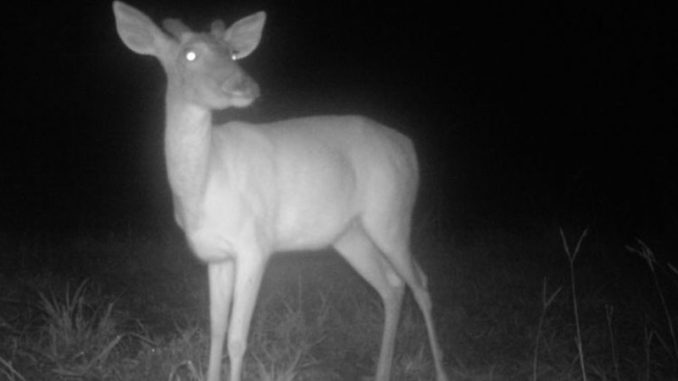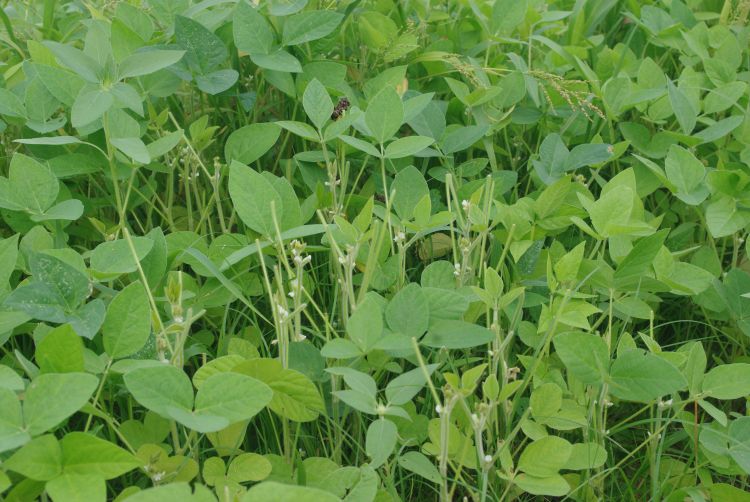
Are you trying to affect the physical condition of the deer on your lease, or just hold them on your property year round?
Louisiana has seen its share of hoopla regarding various deer forages promoted to grow wall hangers.
It all started in the early ’80s with subterranean clover, which was supposed to maintain high deer numbers without having to shoot does and reduce the population density on the landscape.
Hunters could have a lot of deer and also have big deer.
It did not quite work that way.
Then the fad progressed to American jointvetch, Osceola ladino clover, chickory mixed with winter grass, lablab, rape (basically various species of mustards and turnips), forage oats and round-up ready soybeans.
While all of these are great forages for deer, the bottom line concerning food plots is how many pounds (body weight) and inches of antler mass are the plantings actually contributing to buck growth and development.
Most writings regarding deer food plots exclude this kind of information, which is really important for the manager looking to improve his herd.
Back in the day
Prior to 1985, I was working with a landowner’s deer program, which included 1,000 acres of which half was intensely farmed with soybeans, sweet potatoes, corn and winter wheat.
The average live weight for 1½-year-old bucks was 150 pounds, with the largest weighing 175.
When the 1985 Farm Bill came on the scene, farming stopped, crop land was planted in pines or left idle, and 1½-year-old buck weights declined to 120 pounds — and over time declined even more.
And bucks that were once able to produce small basket racks were now spikes.
Even though the landowner still planted food plots, these plantings simply did not provide the high plane of nutrition of the farming operation.
This is why I say the typical club or landowner has to farm the landscape if plantings are to make a difference in the physical condition of the deer. A few acres of plantings is simply not enough to do what is desired.
This is why the largest deer in Louisiana occur on the bottomland hardwood forest habitat associated with real agricultural operations.
What to do
How much of the habitat needs to be planted with year-round forages to make a difference?
Some literature says 6 to 10 percent of available habitat should be in plantings. One seed company states deer managers should plant seven acres for every 100 acres of woods.
The landowner with whom I was working had one acre of agriculture plantings for every one acre of deer woods, and this was having a major impact on deer growth and development.
To have an impact on body weight and antler mass, I would think at least 25 percent of the habitat needs to be in agricultural plantings.
Most clubs and landowners simply cannot do this.
So what should a club or landowner expect from the time, money and effort spent on deer plantings”
I think the approach should be that the planting program will help supplement native forages being produced, and attract and hold deer on the property throughout the year.
The plantings also assist with the annual deer harvest.
The pay off
The greatest benefit is in providing quality forages during the spring and summer months that help keep deer on the property and prevent them from having to range out to find good food sources.
Deer with small home ranges are very important to the small landowner, and studies in Louisiana have shown that if the habitat provides the necessary groceries for deer, both bucks and does will have small home ranges.

The more time a deer spends on the property the more opportunity there is for the hunter during the hunting season.
A good planting program will also provide other wildlife species such as turkey, rabbits, doves and quail with food and cover. Managing the planting program for all wildlife species should be a major consideration of the club or landowner.
For the program to do the above, both spring and fall plantings should be utilized.
Fall plantings provide winter forage for deer during the hunting season, but with the proper seed mix it will greatly enhance the nutrition during the spring season.
Spring plantings provide deer with forage during summer and early fall.
A well-managed planting program could provide hunters with dove hunting opportunity in September, forage to attract rabbits for the opening of the small-game season and food for turkeys during the spring turkey season.
Where should the site be
Site selection is important. Plantings should be more toward the interior of the tract and away from neighbors’ property. The idea is to draw the deer in and, hopefully, keep them around.
It is also wise to avoid areas adjacent to roads and highways; one certainly does not want to pull deer out in the open for all to see.
It is always wise to do soil testing; in the piney woods, soils are normally acidic, so liming is of utmost importance to grow clovers. In fact, liming can be more important than fertilizing.
Stand placement on the sites should also be a consideration. During the winter, winds are generally from the north and northwest, so stand placement should be south and southeast.
I would, however, encourage the use of ground blinds or portable stands, because deer will quickly wise-up to permanent stands over time.
Another consideration is how hunters get to the site: Traveling through the area where deer bed down will not help one have success. There’s nothing worse than going to the stand, and having deer snort and blow at you while they run off.
How big should the site be
Of course, the size of a planting site is important. Small sites planted for the summer months can be quickly eaten up within a few days. Likewise, small winter sites will also be eaten up, losing benefit during the hunting season as well as during the spring growing season when nutrition is really important.
Of utmost consideration, of course, is the equipment one has to use with the planting program. While plots can be made with small equipment and planting no-till seed, the best job is done with tractors and associated implements.
On leased land, planting areas can be limited and restricted to utility rights of way and roadsides. Most timber companies frown at clearing trees, although many will allow the hunters to use logging set sites and other such openings.
A low-budget operation could simply incorporate mowing and planting rye grass, which will attract deer during the season and has some benefit for other wildlife — but don’t expect rye grass to do much for the deer other than attract them during the winter hunting season. A planting program such as this does nothing for the deer during the spring and summer growing season.
Seeds for wildlife plantings
The perfect seed for turkeys is chufa, but if feral hogs are present the chufa will disappear fast.
Deer might eat chufa, but it would not be a crop for deer.
The perfect seed for doves is probably browntop millet (although, for some reason, corn and wheat are often mis-used in September for doves).
I know I could get in trouble with deer hunters and managers, but I will go out on a limb and say the perfect seed for deer is a legume.
Legumes include a variety of forages, including clovers, peas, beans and jointvetch, so it is really a no-brainer.
Winter grasses such as wheat, oats and rye grass are the norm for deer, and these plantings — if allowed to seed out — will provide food and cover for many other wildlife species.
Grain plantings such as corn, Egyptian wheat, sorghum and milo provide food for deer and other wildlife species in the fall and winter.


